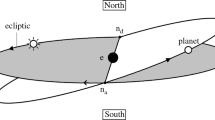Abstract
An extensive analysis of the motion of Phobos and Deimos from 1877 to 1973 has been fulfilled. The new values of the parameters of the orbital model first developed by Struve have been determined for both satellites. The new sets of the orbital parameters compete with the solutions of similar accuracy found by Wilkins and Sinclair. A secular acceleration in longitude of Phobos is found to be equal to +(0.107±0.011)×10−7 deg day−2. The value of the acceleration is little affected when one or another group of oppositions is omitted. The acceleration of Deimos is determined with great uncertainty: +(0.06±0.34)×10−9 deg day−2. Values found for the orbital parameters seem to be in good agreement since the mass, oblateness and coordinates of the pole of Mars inferred from the motion of each satellite have similar values in both cases.
Резюме
Провено обширое исследование движеня Фобоса и Деимоса с 1877 г. п 1973 г. Найдены новые значения параметров теории, впервые разработанной Струве. Новые системы орбитальних параметров конкурируют по точности с решениями, найденными уилкнзом и Синклером. Веквое ускорение вдолготе Фобоса получено равным +(0.017±0.011)×10−7 град день−2. Величина ускорения при отбрасывании той или иной гной группы оппозиций. Ускорение Деймоса определяется весьма неувенно: (0.06±0.34)×10−9 град день−2. Найденне значения орбитальних параметров двух спутников, по-видимому, хорошо согласованы друг с другом, поскольку масса, сжатие и положение полюса Марса, вычисленне по движению каждого спутника, имеют близкие значениь в обоих случаьх.
Similar content being viewed by others
References
Batrakov, Yu. V.: 1966, in M. Lunc (ed.),Trajectories of Artificial Celestial Bodies as Determined from Observations, Springer Verlag, Berlin-Heidelberg, pp. 174–177.
Burns, J. A.: 1972,Rev. Geophys. Space Phys. 10 (2), 463–483.
Dollfus, A.: 1972,Icarus 17, 525–539.
Lorell, J., Born, G. H., Christensen, E. J., Jordan, J. F., Laing, P. A., Sjogren, W. L., Wong, S. K., Reasenberg, R. D., Shapiro, I. I., and Slater, G. L.: 1973,Icarus 18, 304–316.
Pollack, J. B., Veverka, J., Noland, M., Sagan, C., Duxbury, T. C., Acton, C. H., Jr., Born, G. H., Hartmann, W. K., and Smith, D. A.: 1973,J. Geophys. Res. 78, 4313–4326.
Sharpless, B. P.: 1945,Astron. J. 51, 185–186.
Shor, V. A., Glebova, N. I., Sorokina, L. I.: 1971,Astron. Circ., No. 617, Astron. Council Acad. Science, U.S.S.R.
Sinclair, A. T.: 1972,Monthly Notices Roy. Astron. Soc. 155, 249–274.
Struve, H.: 1911,Sitzungsber. Preuss. Akad. Wiss., 1056–1083.
Wilkins, G. A.: 1967, in S. K. Runcorn (ed.),Mantles of the Earth and Terrestrial Planets, Interscience New York, pp. 77–84.
Wilkins, G. A.: 1968, in G. Colombo (ed.),Modern Questions of Celestial Mechanics, Edizione Cremonese, Rome, pp. 221–240.
Wilkins, G. A.: 1970,Inst. Nazion. Alta Matem. Symp. Math. 3.
Author information
Authors and Affiliations
Rights and permissions
About this article
Cite this article
Shor, V.A. The motion of the Martian satellites. Celestial Mechanics 12, 61–75 (1975). https://doi.org/10.1007/BF01228625
Issue Date:
DOI: https://doi.org/10.1007/BF01228625




